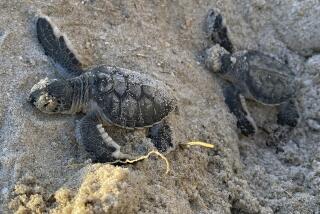Illegal Fishing Blamed for Sea Turtle Slaughter Off India
- Share via
BHUBANESHWAR, India — Thousands of endangered Olive Ridley sea turtles are scooting onto the beaches of India’s eastern Orissa coast for their mass winter nesting. But once again, they are being slaughtered.
Since early November the turtles have landed on beaches including Gahirmatha, one of the world’s four largest nesting sites for the rare turtles. The other three are in Mexico and Costa Rica.
Volunteers from the Wildlife Protection Society of India found 659 dead sea turtles on Nov. 25 during a survey of part of the coastline, and the deaths were expected to rise in December and January, when the turtles congregate along the coast.
Already, approximately 2,000 have died this season, according to reports from volunteers and environmentalist Banka Behari Das.
The turtles get trapped in trawler nets, and fishermen use knives and axes to hack them out. Sea turtles with bleeding wounds and broken shells wash ashore.
“The volunteers were shocked to note the gruesome sight of two live sea turtles on the beach near the mouth of Jatadhar River, bleeding heavily from severe injuries,” Biswajit Mohanty, secretary of the Wildlife Society, said. “One of them had her [shell] broken. Another turtle was bleeding from the head, and her two rear flippers were also chopped off.”
Although the High Court of Orissa state has ordered mechanized fishing trawlers to use devices that help turtles get out of the nets safely, none of the trawlers uses them, the Wildlife Society said. The critically endangered turtles are protected under the same law that bans killing or maiming of tigers.
The turtle protection devices are like trapdoors fitted on the top of the trawling net. If a turtle is caught, a hole opens and the turtle gets out without drowning and without damaging the net.
Das said the device costs $45 to $65. The U.S. National Marine Fisheries Service estimates it costs $215 and reduces an average fish catch by 10% to 15%.
“The problem is, even though these turtles have the highest degree of protection by law, thousands are killed every year,” said Belinda Wright, executive director of the Wildlife Protection Society. “The main reason for this slaughter is illegal fishing along the coast.”
She said the law requires large mechanical trawlers to fish 12 miles from the coast, but they often fish only 100 yards from the shore.
“These turtles congregate there before they come ashore to nest,” she said. “Another twist is that many of these trawlers are owned by politicians, which makes it impossible to stop this illegal act.”
Last March, 67 countries passed a resolution urging the Indian national government and Orissa state to halt the killing of turtles.
“This is an enormous problem, and if India cannot sort it out, these turtles have absolutely no future,” Wright said.
In 1998, turtle lovers and environmentalists from around the world were up in arms against the state government when for the second year in a row the turtles failed to arrive on the Orissa coast for the mass nesting. The activists contend the large-scale killing by trawlers was responsible.
State government officials said the turtles had died of fatigue after their long journey or had been poisoned by pollution.
“This reason is simply unreasonable,” said Priyambada Mohanty-Hejmadi, vice chancellor of Sambalpur University. “The Orissa coast is relatively free of pollution. Even if it were polluted, it is the fish population that should succumb first.”
The State High Court then made it mandatory for trawlers to use the protection devices and ordered the state Fisheries Department to patrol the coast to enforce the ruling.
The turtles reappeared last year, but nearly 20,000 were killed.
More to Read
Sign up for Essential California
The most important California stories and recommendations in your inbox every morning.
You may occasionally receive promotional content from the Los Angeles Times.













